There are 29 different species and subspecies of frogs in Arkansas. These frogs can be found all over the state, but some may be rare.
Frogs are amazing amphibians that share a lot of interesting traits. Drinking water through their skin, changing colors, and leaping far distances are traits most species share.
Frogs live in waters, land, on trees, and even underground. The 29 frog species in Arkansas are interesting and unique in their own way.
Here you will learn about all of the frogs in Arkansas and useful facts about each one. If you live in the state or love learning about different species then you will definitely enjoy this article. Different species of frogs can be identified by their location, mating call, and features. Let’s go over all of the 29 frogs in Arkansas, and what you should know about each of them.
Table of Contents
Frogs in Arkansas
True Toads (Bufonidae) of Arkansas
1. American Toad
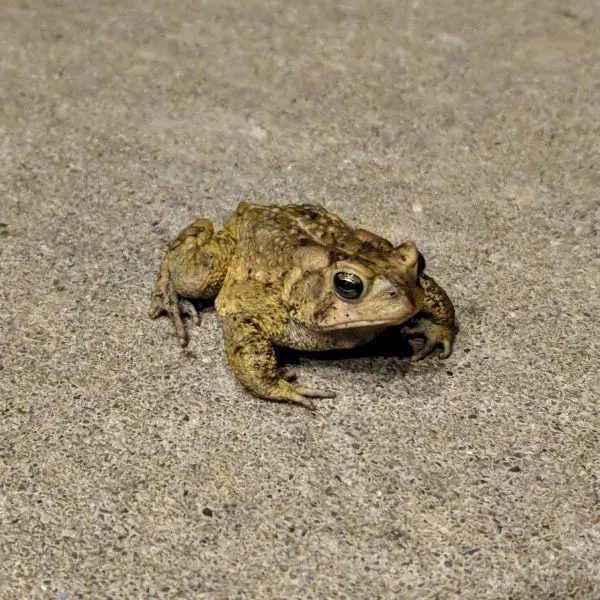
- Experience Level: Beginner
- Family: Bufonidae
- Scientific Name: Anaxyrus americanus
- Other Names: Eastern American toad
- Adult Size: 2 to 3.5 inches
- Lifespan: 2 to 10 years
- Average Price Range: $20 to $30
The American Toads live all over the state of Arkansas. American Toads are one of the most common, and widespread species of toad in the U.S. Hardwood forest, pine forests, open fields, pastures, and even residential areas are some of the habitats they are found in.
This toad is a burrowing species so prefers to live in areas with plenty of sandy soil. Under natural debris and in dark places are also areas they will take shelter.
Ponds, temporary waters, and lakes with no fish are places this species will breed. They are most active from spring to early summer, and that’s when breeding occurs. American toads are least active in dry periods and will hibernate in the winter.
Dark spots cover this species’ back, which has at least two warts in it. Behind their eyes are also parotoid glands that secrete toxins that protect them from being eaten.
Brown, gray, brick red, and olive are common colors for this species. The skin of the American toad is dry, and their bellies portray white coloring. Males are the smaller sex, and during the breeding season will have a dark shade around their throat.
The night is when this species is most active, as during the daytime is spent in their burrows, or hiding under debris. Insects like beetles, moths, and earthworms are what this species usually eats.
Birds, snakes, and mammals are this species’ most common predators. Some are immune to their toxin, but the American toad will also use its camouflage or try to appear larger to defend itself.
2. Fowler’s Toad
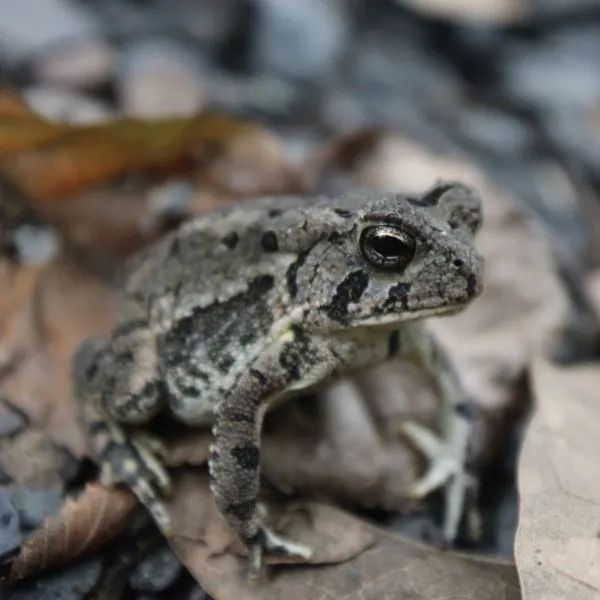
- Experience Level: Beginner
- Family: Bufonidae
- Scientific Name: Anaxyrus fowleri
- Other Names: Bufo fowleri
- Adult Size: 2 to 3 inches
- Lifespan: 2 to 10 years
- Average Price Range: $10 to $20
Abundantly found all throughout the state of Arkansas, Fowler’s toads are a common species to come across. Habitats they live in include woodlands, meadows, beaches, and prairies. Burrows are used as shelter for this species and that is why they prefer to live in sandy areas.
A temporary or permanent water source like a lake, pond, or river is usually near where they live. Spring to fall is when this species will breed. Males can be heard calling from the water during this period, and their call sounds like the bleat of a sheep.
Fowler’s toads have dry skin and are covered in warts. Most of them range from brown to gray, but green and reddish colorations are also possible.
This species is very similar to the American Toad but has three warts in its dark spots instead of two. A cranial ridge and parotoid gland are also present in this species. They have dark blotches on their body, and their bellies have solid white coloring.
Insects are the main food for this species. During the day their time is spent resting, but at night they will hunt. When handling this species you should be cautious about the toxin secreted from their skin, similar to other toads.
This bufotoxin is dangerous for some predators to consume and can even irritate human skin. Fowler’s toads have a healthy population and are even a popular pet for amphibian enthusiasts.
3. Rocky Mountain Toad
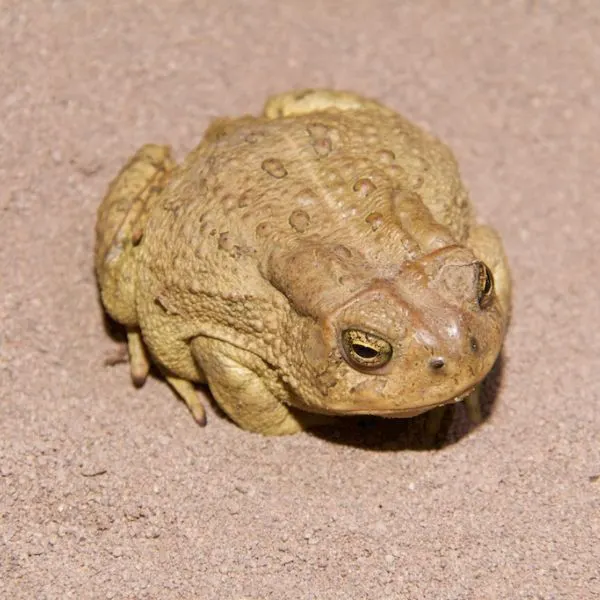
- Experience Level: Intermediate
- Family: Bufonidae
- Scientific Name: Anaxyrus woodhousii woodhousii
- Other Names: Western Woodhouse’s toad
- Adult Size: 2.5 to 4 inches
- Lifespan: 12 years
- Average Price Range: N/A
Rocky mountain toads live in marshes, river bottoms, desert streams, and canyons.
During the day this species will hide in burrows, then become active at night. Breeding for this species occurs from March to August, and they are able to hybridize with the American Toad.
Green, tan, and gray are the colors of this species. Rocky mountain toads have a white stripe running from their head down their back.
Their skin is dry and bumpy. Brown and black spots cover their back, with 1 to 6 warts within each spot.
On their underside is all white coloring. Rocky mountain toads have a cranial crest and parotoid glands behind each eye.
Insects and other small prey are what this species feeds on at night. They help control the insect population but are also a reliable food for aquatic snakes.
Like other toads, this species releases bufotoxin from its parotoid glands which are helpful in stopping predators from feeding on them.
4. Gulf Coast Toad
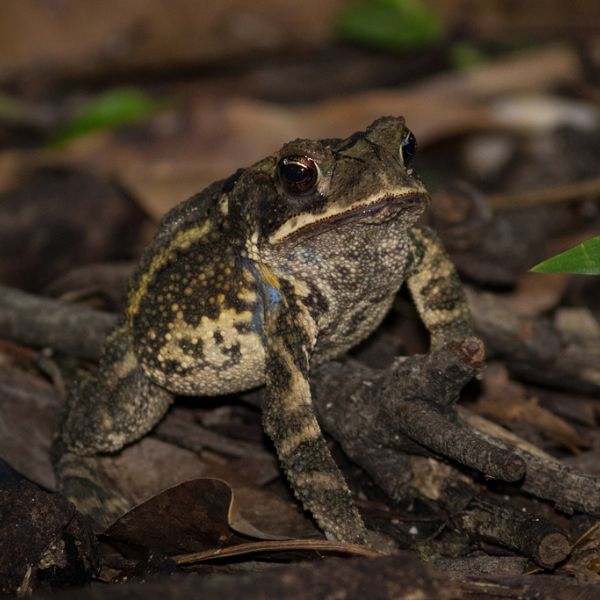
- Experience Level: Beginner
- Family: Bufonidae
- Scientific Name: incilius valliceps
- Other Names: Coastal plains toad, Central American Gulf Coast Toad
- Adult Size: 2 to 4 inches
- Lifespan: 10 years
- Average Price Range: $10
The gulfs coast toads are a rare species to come across in Arkansas, only found in the most southern point of the state. Prairies, beaches, and suburban areas are habitats they live in.
They are also found in Mexico and Costa Rica. A permanent water source is common in the areas they live, and they will breed in these sources to breed. Sometimes they travel to look for food or mates.
This species is medium-sized and ranges from shades of black, brown, or gray. They have a light-colored stripe running down their back, and blotches on their sides. The belly of the gulf coast toad is white, and they have small bumps covering their back.
Small arthropods and insects are the foods that this frog will feed on. They are opportunistic feeders and will eat anything they can come across.
Like other toads, their predators include mammals, snakes, and large birds.
American Spadefoot Toads (Scaphiopodidae) of Arkansas
5. Eastern Spadefoot Toad
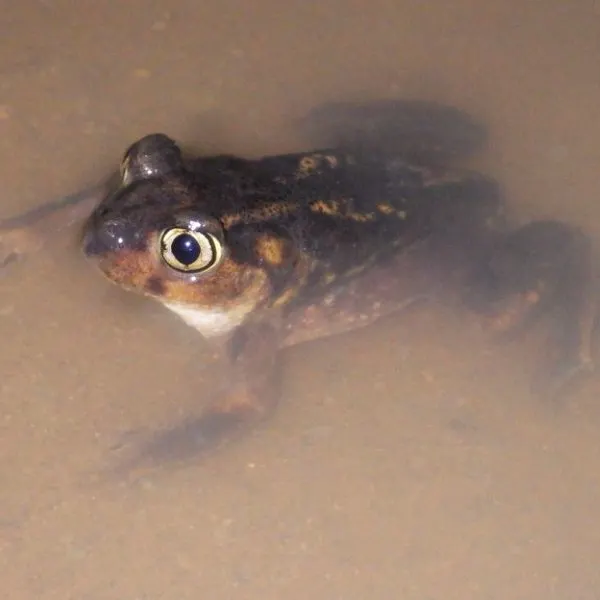
- Experience Level: Beginner
- Family: Scaphiopodidae
- Scientific Name: Scaphiopus holbrookii
- Other Names: The Spadefoot toad
- Adult Size: 1.75 to 2.25 inches
- Lifespan: 2 to10 years
- Average Price Range: $10 to $20
Eastern spadefoot toads can be found in the Eastern United States, and the eastern border of Arkansas.
They live in areas with sandy soil and spend most of their life underground. This species can sometimes be found in residential areas, but you may not even know it since they can spend years underground.
Breeding will cause this species to leave its burrows, which happens in heavy rainfall and thunderstorms. When breeding occurs it happens in temporary water pools, and as many as 2,500 eggs can be laid by a female.
Eastern spadefoot toads are smaller than other toad species. They also have smooth, moist skin, and are covered in tiny warts. Tan, dark brown, yellow, and olive are the colors this species is found in.
Running from their eyes down their back are two tan lines. The black spade on their hind foot helps them dig and also gives this species its name. Spadefoot toads are known for their large yellow eyes that have cat-like elliptical pupils.
Hunting is another time when this species decides to leave its burrow and go to the surface. Ants, beetles, grasshoppers, spiders, and termites are some of the small animals they feed on.
All it takes is one meal for this species to be satisfied for months. Spadefoot toads are a rare frog to come across. They spend most of their lives in their burrows, but when they do come out it is usually at night, or in heavy rain.
5. Hurter’s Spadefoot Toad
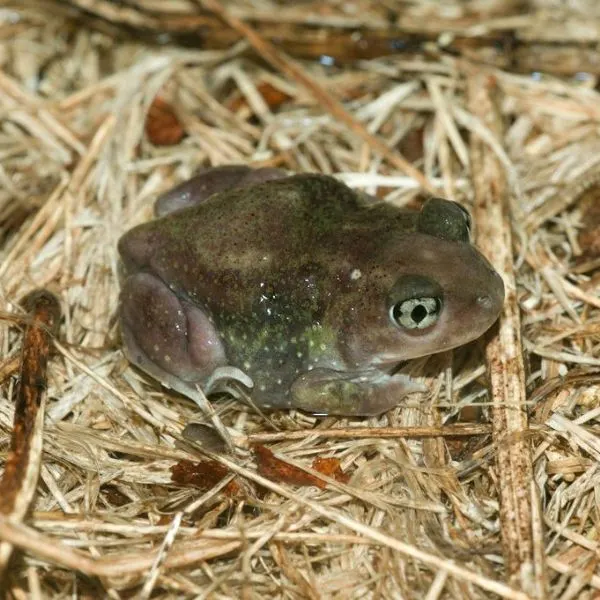
- Experience Level: Beginner
- Family: Scaphiopodidae
- Scientific Name: Scaphiopus hurterii
- Other Names: N/A
- Adult Size: 2.8 inches
- Lifespan: 2 to 10 years
- Average Price Range: $10 to $20
Hunters spadefoot toads have a scattered population in the state of Arkansas. They live in habitats like woodlands, savannas, or open areas with loose sandy soil. This species was once thought to be the eastern spadefoot toad but is now its own species.
They will spend most of their time underground but will come out in heavy rainfall to breed. Temporary water sources and ponds are used for breeding.
Hurter’s spadefoot has a black spade on their hind feet like other spadefoot toads. They are covered in small warts and have large yellow eyes. Their eyes look similar to cats, and their body has a round shape.
For most of its life this species will remain underground, and only come out to eat and breed. At night they may hunt for insects and small invertebrates.
Spiders, beetles, moths, ants, and termites are common things they eat. They can go years without exiting their underground burrows, and why spotting this species in the wild can be difficult.
6. Plains Spadefoot Toad
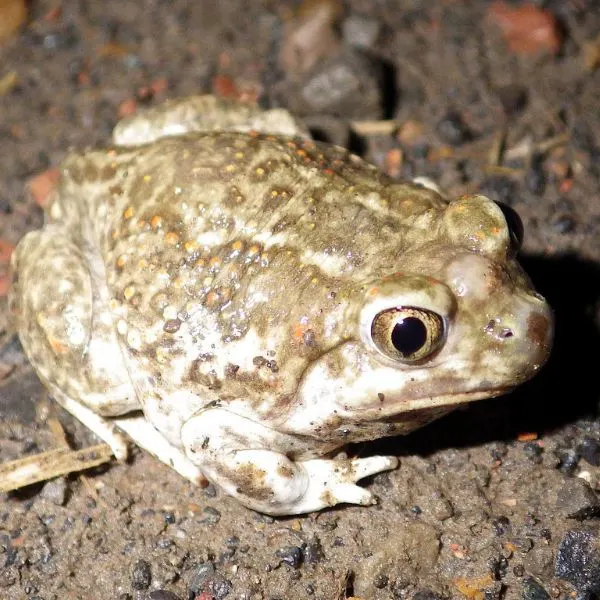
- Experience Level: Beginner
- Family: Scaphiopodidae
- Scientific Name: Spea bombifrons
- Other Names: N/A
- Adult Size: 1.5 to 2.5 inches
- Lifespan: 5 to 10 years
- Average Price Range: Around $10
Plains spadefoot toads are a rare species to find in Arkansas, only located near the Arkansas River Valley. This species has a large range in the Central U.S but is extremely rare in Arkansas.
Open fields and plains are habitats this species lives in. They prefer soft sandy soil in the areas they live in since they are a burrowing species.
After heavy rains this species will come out to breed, mating in nearby ponds. As many as 2,000 eggs are laid by a female, which hatches in 2 days. The tadpoles will mature around 2 weeks.
Brown, tan, and olive-gray are common colors for this species. They are covered in dark blotches and red warts. Their stomach is white and displays no pattern.
Their eyes are large, yellow, and have cat-like elliptical pupils. Spadefoot toads are most known for the dark keratinized spade on their hind feet, which help them dig.
Ants, grasshoppers, worms, and crickets are some of the animals that this species will eat. This species is extremely rare to come across in Arkansas because of its low population and secretive lifestyle.
Narrow-mouthed frogs (Microhylidae) of Arkansas
7. Eastern Narrow-mouthed Toad
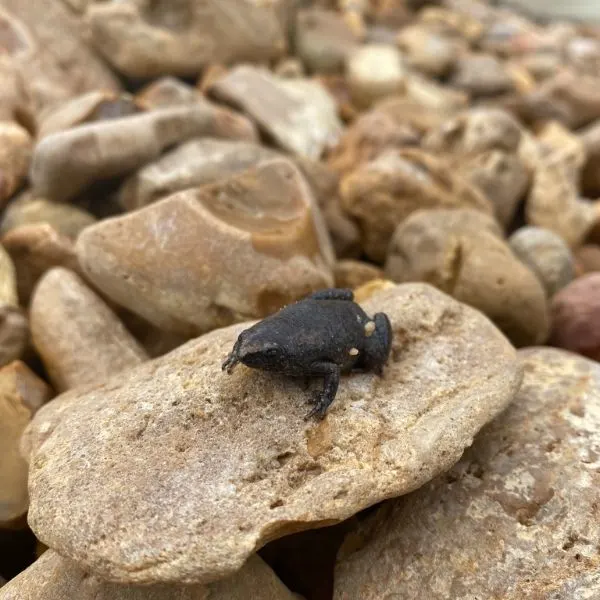
- Experience Level: Beginner
- Family: Microhylidae
- Scientific Name: Gastrophryne carolinensis
- Other Names: N/A
- Adult Size: 2.1 inches
- Lifespan: 6 years
- Average Price Range: $10
Eastern narrow-mouthed toads have a range in the southeastern United States and live all over the state of Arkansas. They live in a variety of habitats but are usually found in moist areas with plenty of leaf litter.
This species is nocturnal and will hide under rocks, logs, and other natural debris. Breeding occurs in summer during heavy rain, and they will mate in fishless waters.
The narrow mouth of this species is what gives them their name, as they have pointed heads. Their skin is moist and has minimal warts.
Brown to gray is the most common color they appear in but will change their shade depending on their mood and environment. Eastern narrow-mouthed toads are covered in a mottled pattern and have a moist look to them.
Ants are the main invertebrate this frog feeds on since they can easily fit in their tiny mouths. To defend themselves they are able to secrete a mild poison from their body.
This toxin protects them from ant bites but does not come from a parotoid gland, like true toads.
8. Western Narrow-mouthed Toad

- Experience Level: Beginner
- Family: Microhylidae
- Scientific Name: Gastrophryne olivacea
- Other Names: Great plains narrow-mouthed toad
- Adult Size: 1.5 inches
- Lifespan: 6 years
- Average Price Range: $10
Western narrow-mouthed toads have a scattered range across western Arkansas. They are found in woodlands with an abundance of natural debris.
Logs, leaf litter, and rocks are places they will hide under. From spring to summer they will breed when it rains, usually in temporary and slow waters.
Western narrow-mouthed toads have pointed heads and flat bodies. Their mouth is smaller than most frogs and can help identify this species.
They can be gray, tan, or green. Small specks cover their body, and their belly is a cream color with no markings.
This species is very similar to the Eastern Narrow-mouthed toad, but that frog does not have green coloring. The eastern narrow-mouth toad also has more blotches covering its back.
Ants are the main food source this species eats. The secretion from their skin protects them from ants bites, and also makes tarantulas not want to eat them.
Narrow-mouthed toads are found near tarantula holes and prevent ants from inhabiting the tarantulas’ burrows.
True Frogs (Ranidae) of Arkansas
10. Crawfish Frog

- Experience Level: Intermediate
- Family: Ranidae
- Scientific Name: Lithobates areolatus
- Other Names: N/A
- Adult Size: 2.5 to 3 inches
- Lifespan: 7 years
- Average Price Range: N/A
Crawfish frogs have a scattered range in Arkansas, living in areas with a healthy crawfish population. This species can be found in grasslands, pastures, and rivers.
They will use crawfish holes as burrows and will breed in freshwater pools. This species spends most of its life in burrows, and why studying them can be difficult.
Crawfish frogs can be gray or brown. They have blotches covering them that have a light border around them.
A yellow dorsolateral stripe can be seen on the body, and they have yellow coloring between their hind legs. Crawfish frogs have pale bellies and are medium-sized species.
Habitat loss, pollution, and reliance on crawfish are why this species has been slowly on the decline. They feed on insects, crawfish, and other small animals.
Finding one of these frogs is rare since they will hide for the majority of their life.
11. Plains Leopard Frog
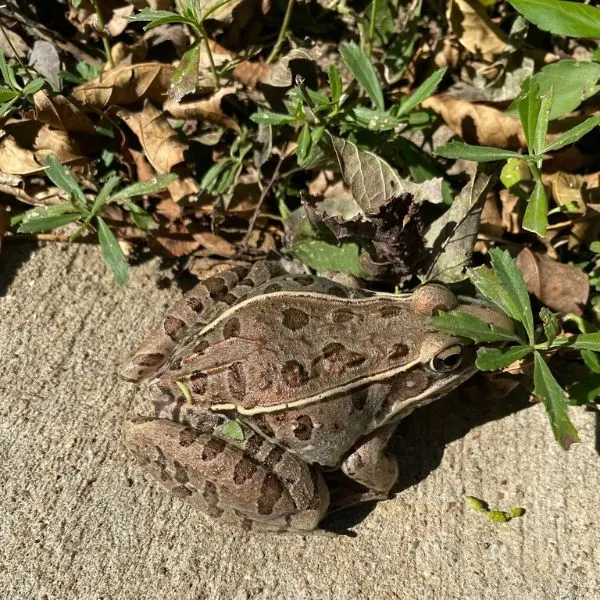
- Experience Level: Beginner
- Family: Ranidae
- Scientific Name: Lithobates blairi
- Other Names: Blair’s leopard frog
- Adult Size: 2 to 4.25 inches
- Lifespan: 2 to 4 years
- Average Price Range: $10 to $30
Plains leopard frogs have a small range in Arkansas along the northern border of the state. Freshwater like rivers, ponds, wetlands, and streams are present in their living area.
In spring they mate and are more active in rainy seasons. This frog will occasionally come onto land to travel and find more breeding pools.
Plains leopard frogs have dark blotches covering their back and a bar pattern on their legs. Green, brown, and gray are common colors for this species.
They have two dorsolateral stripes running down the sides of their back. On this species belly is pale white coloring with no pattern.
Insects and invertebrates are what leopard frogs usually feed on. The plains leopard frog has been on the decline similar to other amphibians due to disease and habitat loss.
Predators of this frog include bullfrogs, raccoons, and snakes.
12. Coastal Plains Leopard Frog

- Experience Level: Beginner
- Family: Ranidae
- Scientific Name: Lithobates sphenocephalus utricularius
- Other Names: N/A
- Adult Size: 2 to 3.5 inches
- Lifespan: 2 to 4 years
- Average Price Range: N/A
Coastal plains leopard frogs are found in coastal plains and piedmont habitats. They are found all over Arkansas and are a common species to come across.
This frog uses brackish freshwater to breed, which is usually done in late winter to early spring. They will lay around several hundred eggs in shallow water, and hatch within the next few weeks.
Elongated spots cover this species, but sometimes they have no markings. Coastal plains leopard frogs will range from brown to green and have ridges running down their sides.
Females of this species are larger than males. Pointed heads and white bellies are also traits of this frog.
Worms, insects, and invertebrates are what they eat, sometimes preying on small mammals. They are active at night and will hide in vegetation during the day.
13. Pickerel Frog
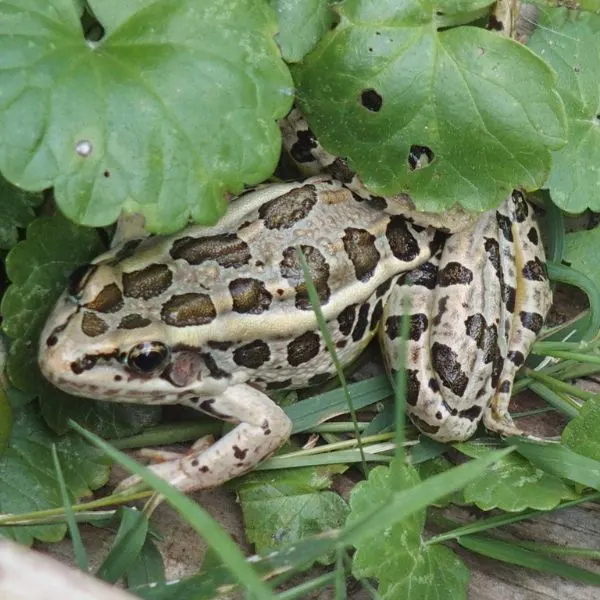
- Experience Level: Intermediate
- Family: Ranidae
- Scientific Name: Lithobates palustris
- Other Names: Rana palustris
- Adult Size: 1.75 to 3 inches
- Lifespan: 5 to 8 years
- Average Price Range: $10 to $15
Pickerel frogs live all across Arkansas and have a range covering most of the eastern United States.
This frog lives in cool, unpolluted waters. Streams, ponds, lakes, and other freshwaters are where this species can be found.
Pickerel frogs are often mistaken for leopard frogs, but their blotches are more square and are in parallel rows. They have a white line on their upper jaw and bright orange coloring in between their hind legs. The underside of this species is white or yellow, and they have long legs.
Insects such as water bugs, flies, and ants are what this frog feeds on. They release a toxin from their skin that is poisonous. This toxin can kill small animals, irritate human skin, and even kill other frogs.
14. Green Frog
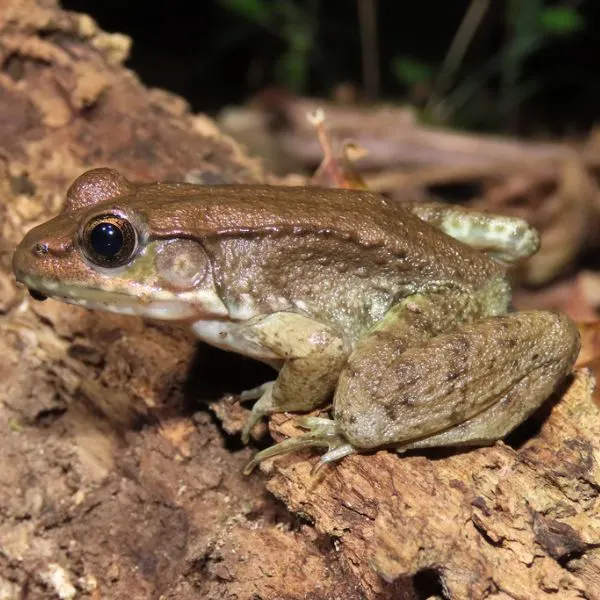
- Experience Level: Beginner
- Family: Ranidae
- Scientific Name: Lithobates clamitans
- Other Names: NorthernGreen Frog
- Adult Size: 2.4 to 5 inches
- Lifespan: 16 to 20 years
- Average Price Range: $10
Green frogs are an aquatic species, living near the edges of freshwater habitats. Ponds, swamps, rivers, marshes, springs, and lakes are some of the places they can be found.
Water with aquatic vegetation is where they prefer to live, not usually going away from their water pool. Rainy nights will cause this species to be more active and venture onto land.
Green frogs are large and can be brown or green. They have small dark spots covering them and an external eardrum. Green frogs have short legs, and males will have bright yellow throats.
This frog is often mistaken for a bullfrog, but they are smaller in size. They feed on anything they can find, usually insects, and smaller frogs.
Green frogs are active from spring to fall and will hibernate in the winter.
15. American Bullfrog

- Experience Level: Intermediate to Advanced
- Family: Ranidae
- Scientific Name: Lithobates catesbeianus
- Other Names: lithobates catesbeianus
- Adult Size: 3.5 to 8 inches
- Lifespan: 7 to 15 years
- Average Price Range: $20
Bullfrogs are the largest frog species in North America, and one of the most common. This species is found across Arkansas and will live near freshwater habitats.
Ponds, streams, and slow-moving waters are where bullfrogs are normally found. They will also inhabit permanent water sources like lakes, and rivers.
The sound of this frog is like a bull and that is why they get their name. Originally native to the Eastern United States, they have become an invasive species and have found their way all across the U.S.
This frog is one of the largest in the world and U.S., regularly reaching more than 6 inches. They have brown and green skin, with large features.
Bullfrogs have a large outer eardrum on the side of their head. They have moist skin, and webbed feet to help their aquatic lifestyle. This frog has a bright green upper lip, and their underside is white with a mottled pattern.
Bullfrogs will eat anything they can find from other frogs, birds, insects, snakes, lizards, and rodents. Their aggressive nature makes them a problem in areas they are invasive to.
Bullfrogs are active from spring to fall, and this species makes for one of the most common pet frogs.
16. Wood Frog
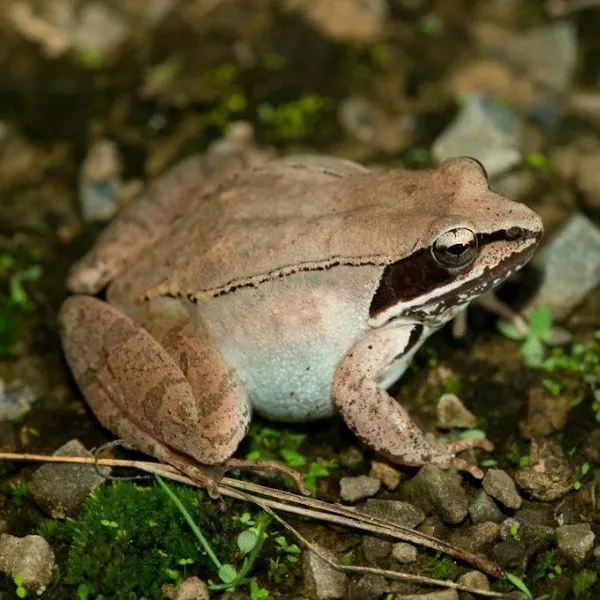
- Experience Level: Beginner
- Family: Ranidae
- Scientific Name: Lithobates sylvaticus
- Other Names: Rana sylvaticus
- Adult Size: 1.375 to 2.75 inches
- Lifespan: 1 to 3 years
- Average Price Range: $15 to $30
Wood frogs are found in the northwestern corner of Arkansas and are mainly found in the Northeastern half of the United States. They live in mountains, woodlands, and moist habitats.
They are active on rainy nights and live near ponds. During breeding, they will congregate in freshwater and mate in large numbers.
In their body is a unique anti-freezing substance that prevents them from dying in cold temperatures. This species is one of the most cold-resistant frogs.
Wood frogs are brown, with a black mask on their eyes. Other possible colors include gray, pink, or reddish.
The females are larger in size, but males have more vibrant colors. Males use their colors to attract females, and the female’s large sizes give them the capability to breed more successfully.
Wood frogs feed on small invertebrates like spiders, snails, flies, and beetles. They use their camouflage to hide from predators and blend into leaf litter.
In winter they are not active and will freeze under leaf litter until the next season arrives.
Tree Frogs (Hylidae) of Arkansas
17. Spotted Chorus Frog
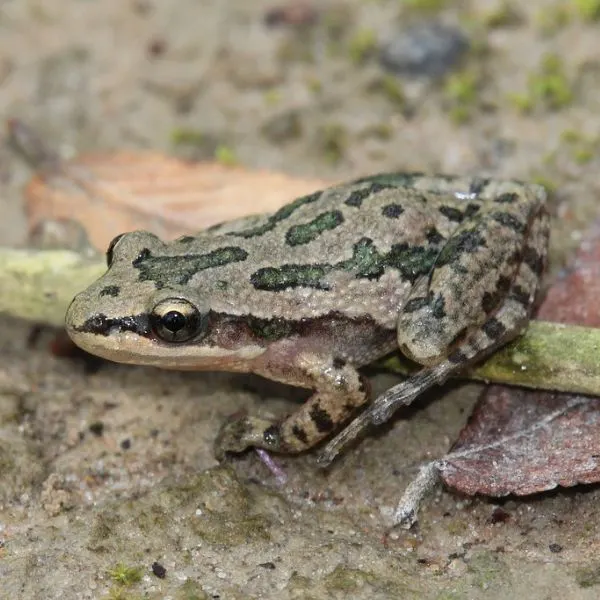
- Experience Level: Intermediate
- Family: Hylidae
- Scientific Name: Pseudacris clarkii
- Other Names: Clark’s Tree frog
- Adult Size: 1.25 inches
- Lifespan: 2 years
- Average Price Range: N/A
In the state of Arkansas spotted chorus frogs are rare and are only found in a small area within the southwestern corner of the state.
Grasslands, prairies, meadows, and woodlands are some of the habitats they live in. When not active this species will go underground like other chorus frog species.
These frogs range from green to gray and have a mottled pattern on their back. Around their edges, they have dark brown coloring, and their bodies are covered in blotches.
Unlike other chorus frog species they do not have a dark line running down their back, and their underside is a cream color.
Spotted chorus frogs rely on their small size and camouflage to avoid predators. Water snakes, ribbon snakes, and garter snakes are common predators of this species.
This small frog feeds on insects, flies, moths, and other invertebrates. They are experiencing population decline because of pollution and habitat loss.
18. Upland Chorus Frog

- Experience Level: Intermediate
- Family: Hylidae
- Scientific Name: Pseudacris feriarum
- Other Names: N/A
- Adult Size: 0.75 to 1.375 inches
- Lifespan: 1 to 5 years
- Average Price Range: N/A
All over Arkansas and the eastern United States, the upland chorus frog is a common species. These frogs usually live near flooded wetlands and fields.
Woodlands, meadows, and swamps are also areas they live in. They will breed in slow-moving waters like wetlands or ditches. They are active from early spring, until fall.
This chorus frog species is small, and colored brown to gray. They have a white line across their lip and a dark stripe that runs through their eye. Light blotches cover this species body, and they have a cream-colored underside.
Being so small they eat small insects and invertebrates. They are eaten by snakes, and water birds in their habitat. Upland chorus frogs will call from the water, which sounds like a finger running through a comb.
19. Strecker’s Chorus Frog
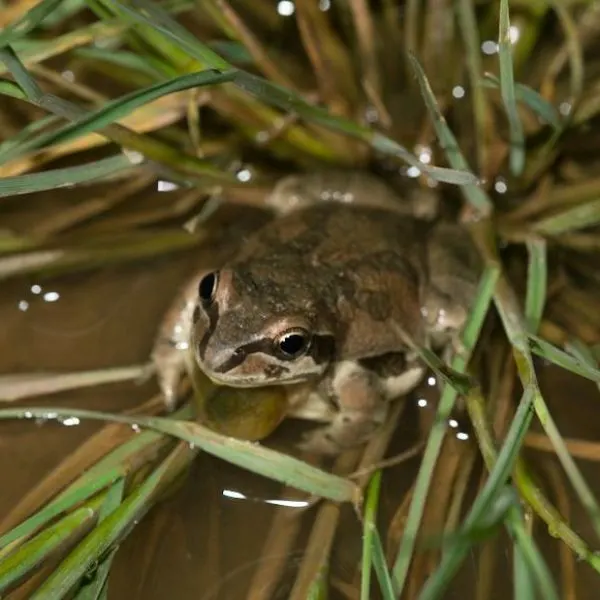
- Experience Level: Intermediate
- Family: Hylidae
- Scientific Name: Pseudacris streckeri
- Other Names: N/A
- Adult Size: 1.5 to 2 inches
- Lifespan: 5 years
- Average Price Range: N/A
Strecker’s Chorus frog is a small tree frog species that mainly inhabit areas within the South Central United States. In Arkansas, they are only found in the eastern part of the state.
Woodlands, and fields are habitats they live in. Ponds, flooded ditches, and other small bodies of water are usually nearby, and they use these to breed.
When not breeding they bury themselves underground and hibernate in the winter.
This chorus frog can be gray, olive, tan, or green. They are covered in black spots and have blotchy stripes that run down their back. Under their eye is a dark bar.
Unlike other species of chorus frogs, they lack the light-colored line near their upper lip. Their body is rough, similar to the texture of a toad.
Like other chorus frog species, the Strecker’s chorus frog has experienced a decline in its population due to habitat loss. Strecker’s chorus frogs eat small invertebrates and insects.
When compared with other chorus frog species, Strecker’s chorus frogs are more terrestrial.
20. Boreal Chorus Frog

- Experience Level: Intermediate
- Family: Hylidae
- Scientific Name: Pseudacris maculata
- Other Names: N/A
- Adult Size: 0.75 to 1.5 inches
- Lifespan: 1 to 3 years
- Average Price Range: N/A
Boreal Chorus frogs have a small range in Arkansas along the extreme northern border of the state. In the United States, their range stretches from the Central U.S up to Canada.
Boreal chorus frogs will live near permanent bodies of water to breed. Wetlands and fields with trees are common habitats they live in. From around late February to April this species begins to breed.
They have a quick lifespan, hatching within a few weeks eggs are laid, and maturing into full frogs by summer. In winter they will hibernate underground and beneath debris.
This frog is a small species that ranges from gray, green to brown coloring. They have smooth skin and dark blotches covering their back.
Going through their eyes is a dark stripe that reaches their snout. Above their mouth is a white stripe and their belly is white covered in a mottled pattern.
Small insects and spiders are the main food source for this species. Wading birds, meat-eating mammals, and snakes are what eat this species.
Even though they have a small population in Arkansas, they have a stable population and are listed as ‘Least Concern’ in the U.S.
21. Illinois Chorus Frog

- Experience Level: Intermediate
- Family: Hylidae
- Scientific Name: Pseudacris illinoensis
- Other Names: N/A
- Adult Size: 1.5 inches
- Lifespan: 1 to 3 years
- Average Price Range: N/A
Illinois chorus frogs are rare in Arkansas, and can only be found in the small north-eastern corner of the state. They are also found in Missouri and Illinois but are a rare endangered species.
They mostly live in wetlands with sandy habitats near the Mississippi and Illinois river. They will mate in late February, until April. In winter they hibernate and burrow below the frost line.
This species is small with tan to gray coloring. They have dark blotches and lines on their back. Their belly is smooth with slight bumps.
The underside of this species is white, and males will have dark throats during the breeding season. This chorus frog has stronger legs than other species of frogs and digs with a breaststroke motion.
In Arkansas, Illinois chorus frogs lived in rice fields but lost most of their population through the land being farmed. In other areas habitat loss is the main threat of this species.
Insects and burrowing larvae are the main food of this species.
22. Cajun Chorus Frog
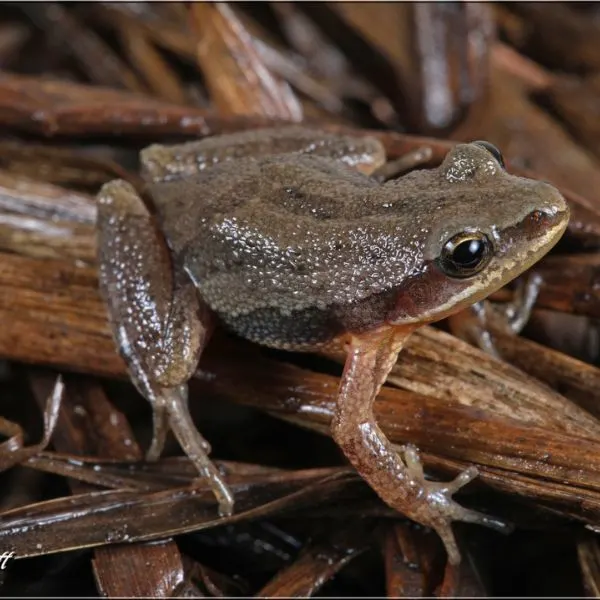
- Experience Level: Intermediate
- Family: Hylidae
- Scientific Name: Pseudacris fouquettei
- Other Names: N/A
- Adult Size: 1 to 1.25 inches
- Lifespan: 2 to 5 years
- Average Price Range: N/A
Cajun Chorus frogs are found all over the state of Arkansas. They live in woodlands, agricultural areas, and old fields. From the beginning of the year until April this species breeds.
Wetlands, flooded ditches, wet prairies, and temporary ponds are areas they breed in. Females lay around 20 to 100 eggs, which are submerged in the water attached to vegetation.
Cajun Chorus frogs are a small species that are colored gray to brown. They have dark stripes on their back, and a dark stripe running through their eye.
Beneath their dark eyes, is a white-colored stripe. They have black pupils with a golden iris outline. This species was originally thought to be the upland chorus frog but is now classified as its own species.
Similar to other chorus frogs, this species is nocturnal and can be heard calling from the edges of the water. They feed on small invertebrates and insects.
Fish, snakes, and meat-eating mammals are what preys on this species the most.
23. Blanchard’s Cricket Frog
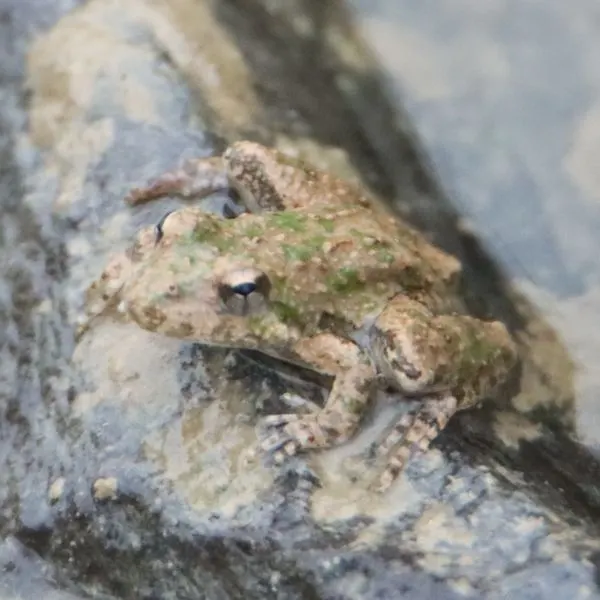
- Experience Level: Beginner-Intermediate
- Family: Hylidae
- Scientific Name: Acris crepitans blanchardi
- Other Names: N/A
- Adult Size: 0.625 to 1.5 inches
- Lifespan: 1 year
- Average Price Range: N/A
Living all over Arkansas, the Blanchard’s Cricket frog is one of the most common species to come across in the Midwest.
They live in forests, swamps, creeks, and agricultural areas. Slow-moving waters are where they usually breed in spring to early fall.
This species is active from March to November. In winter they will bury themselves and hibernate.
This species is small and covered in warts. Gray, tan, and green are their possible colors.
Dark bands cover their body, and a triangle mark is located on their head. Blanchard cricket frogs have a call that sounds similar to marbles clicking together.
This species is a common frog in the midwest of the United States but has experienced population decline in certain areas. In some states like Wisconsin, they have become endangered.
Pollution is one of the main causes for this frog’s decline since their highly vascularized skin makes it easy for their skin to absorb toxic substances.
24. Western Bird-voiced Treefrog
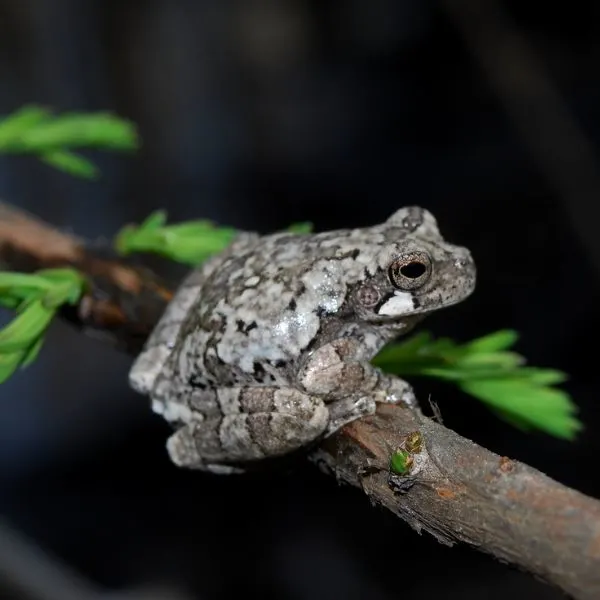
- Experience Level: Intermediate to Advanced
- Family: Hylidae
- Scientific Name: Hyla avivoca
- Other Names: N/A
- Adult Size: 2 inches
- Lifespan: 2.5 to 4 years
- Average Price Range: N/A
Western Bird-voiced tree frogs are found in Arkansas in the southwestern, and central regions. They live in swamps, creeks, and in other wetland-type habitats.
Breeding for this species occurs from April to July, and they will spend time near tree branches over swamps calling for a mate. Their call sounds similar to a bird’s chirp and is also what gives them their name.
Green, gray, and brown are common colors for this species. They have coloring-changing abilities like other frogs, that help them camouflage into their environment.
A mottled pattern covers this species. Their bellies, legs, and hands are a light gray color. They also have yellow coloring on their hind legs that they will flash to confuse predators.
Bird-voiced tree frogs are nocturnal, and can sometimes be seen hunting for insects at night. It is rare to spot this species since they spend most of their time high in trees, only coming to lower levels in breeding to breed.
This species has a healthy population within its range and is not a threatened species when concerning its population.
25. Cope’s Gray Treefrog
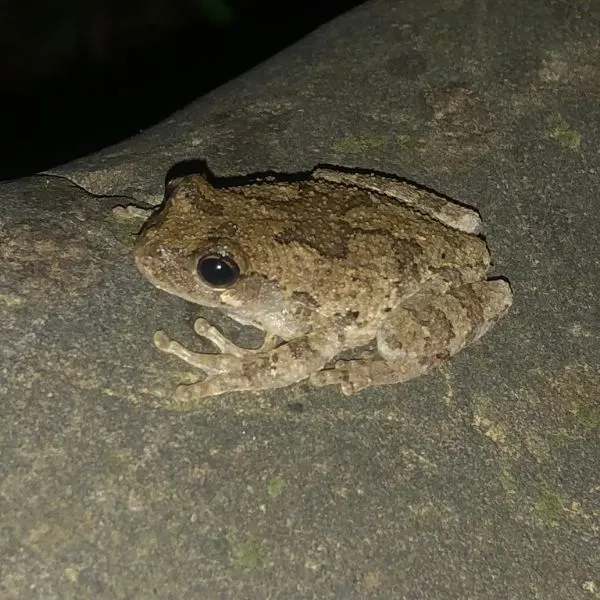
- Experience Level: Beginner to Intermediate
- Family: Hylidae
- Scientific Name: Dryophytes chrysoscelis
- Other Names: Southern Gray Treefrog
- Adult Size: 1.25 to 2 inches
- Lifespan: 10 to 15 years
- Average Price Range: $20
Cope’s Gray Tree Frogs are found everywhere in Arkansas, except in the far northern section of the state. They can be found in pine forests, fields, and are habitats they live in.
In Spring, to early fall this species will breed. Temporary waters like ponds, wetlands, and ditches are used for breeding. In winter they are not active and hibernate until the next season.
Gray is the most common color for this species, but it can also range in colors from green to brown. A mottled pattern covers their back, and they can easily camouflage into the bark of trees.
Cope’s Gray tree frogs are able to change their color to match their environment. Their underside is pale, and yellow coloring is present in their hind legs.
Since this insect spends most of its time in the trees, its primary food source is flying insects like mosquitoes and flies. They will also eat other insects that they come across, and do most of their hunting at night.
Cope’s Gray Tree Frogs are a common species in their range but are affected by pollution and habitat loss.
26. Gray Tree Frog

- Experience Level: Beginner to Intermediate
- Family: Hylidae
- Scientific Name: Dryophytes versicolor
- Other Names: Northern Gray Treefrog
- Adult Size: 1.25 to 2 inches
- Lifespan: 7 to 9 years
- Average Price Range: $20
In the eastern half of the U.S and most of Arkansas, the gray treefrog is a common species to find. Forests are common habitats they live in, as they enjoy spending most of their time in trees.
Gray tree frogs can even be found in residential areas. Breeding occurs in fishless waters like swamps, ponds, and vernal pools. In winter they will hibernate and are capable of surviving freezing temperatures.
Gray treefrogs are all gray and have the ability to change their color to blend into their environment. They have a mottled pattern covering their body. Gray Tree Frogs have orange or yellow coloring on the inside of their hind legs.
The cope’s gray tree frog and gray tree frog are nearly identical in appearance. The Gray Tree frog can be distinguished from the Cope’s Gray Treefrog because of its slower call.
Insects are this species main source of food, and they are active hunters at night. Spiders, flies, plant lice, and beetles are some animals they hunt for.
They spend most of their time in trees and use their camouflage to avoid predators. Snakes and carnivorous mammals are the most common prey for this frog.
27. Green Tree Frog

- Experience Level: Intermediate
- Family: Hylidae
- Scientific Name: Dryophytes cinereus
- Other Names: American green tree frog
- Adult Size: 2 to 2.5 inches
- Lifespan: 2 to 6 years
- Average Price Range: $10
Green tree frogs are found statewide in Arkansas and have a range covering the southeastern area of the U.S. Ponds, lakes, wetlands, and swamps are some of the habitats they live in. Most of the time this frog will spend its time in trees, and on plants next to water.
From spring to fall, they will breed, and males will call from the water. They can be found in high numbers together during this season.
This species is medium-sized and has long limbs. Sticky pads are located on their toes like other tree frogs to help them climb.
Green is their base color, and a white, or yellow stripe runs down their side. Yellow spots appear on their backs. Males are smaller than females.
Insects are the main things this species eats, and they will spend time near the light that attracts insects. Since they are found in high numbers, green frogs are listed as least concerned.
In captivity, this species will live longer, but in the wild disease, pollution and habitat destruction shorten their lifespan.
28. Squirrel Treefrog

- Experience Level: Intermediate
- Family: Hylidae
- Scientific Name: Hyla squirella
- Other Names: Rain frogs
- Adult Size: 1 to 1.5 inches
- Lifespan: 5 to 9 years
- Average Price Range: $10
Only native in the southeastern United States, the squirrel tree frog can also be found in a small southern region within Arkansas. Swamps, marshes, streams, lakes, and other edged water habitats are where this species can be found.
Moist areas with high vegetation are the common places they can be found. In the seasons they are active they can be heard calling, which sounds similar to a squirrel chattering.
Breeding for this species occurs from spring to fall, and the rain also makes this species become more active.
Squirrel tree frogs look similar to other species of treefrog but looking at key identify traits that other species have can help identify them. They are medium-sized, with green, yellowish, or brown skin.
To better blend in with their environment each individual can change their shade and coloring. Blotches, bars, and stripes are present on some of these frogs, but others can be plain.
Insects are what this species usually eats, occasionally using outdoor lights to find more insects. Termites, beetles, spiders, and flies are some of the insects they eat. Droughts and changes in water salinity are issues this species faces, but they still have a stable population within their range.
29. Spring Peeper

- Experience Level: Intermediate
- Family: Hylidae
- Scientific Name: Pseudacris crucifer
- Other Names: Spring peeper
- Adult Size: 0.75 to 1.25 inches
- Lifespan: 2 to 4 years
- Average Price Range: $10 to $20
Spring Peepers are located all over the state of Arkansas. They live in forests, wetlands, and swamps. Spring peepers are one of the first frogs to become active after winter, and their call is a sign that spring is coming.
From Early to mid-spring this species will breed in shallow, temporary waters like marshes, ponds, or swamps. In winter they become inactive and will freeze when hiding in trees or under logs.
A small species, they come in shades of brown, tan, gray, or green. They have dark blotches covering their body and legs. On their back is a large X mark.
On the inside of their hind legs is faint yellow coloring. They have smooth, moist skin with no warts. Spring peepers have large toe pads to help them climb like other tree frogs, but are a more terrestrial species.
Insects are the main food source they rely on but will eat other small invertebrates. They are nocturnal and spend their time feeding on the prey they find.
In deep woodlands, they are active both day and night. Being so small they are preyed on by larger predators like bullfrogs, skunks, snakes, and other large animals.
Wrapping up
The 29 frogs in Arkansas live all over the states, and some can even be found in your backyard. Frogs are a sign of a healthy environment, but many species have been slowly losing their population.
Pollution is one of the biggest threats to frogs since most use a water source to breed. The destruction of their habitat is another cause why frogs have slowly been on the decline.
Some species are less affected, and protecting frogs helps keep a balanced ecosystem. Insects are the main food for most frogs, and they will help to control their population.
Frogs are one of the most unique pets to keep, and some of them can even live close to a decade. Learning about different species can help best decide which is best for you.
Some frogs on this list can be great pets and most are entertaining to observe in the wild. When comparing the frogs in Arkansas the 29 species can be quite similar, but each one has interesting things to know about them.
Nearby States
- Frogs in Louisiana
- Frogs in Mississippi
- Frogs in Missouri
- Frogs in Oklahoma
- Frogs in Tennessee
- Frogs in Texas
